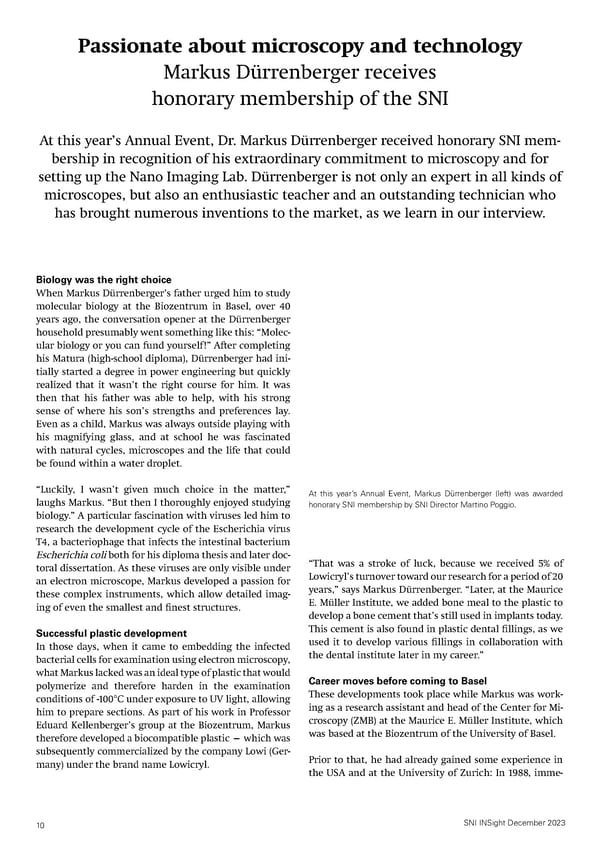Passionate about microscopy and technology Markus Dürrenberger receives honorary membership of the SNI At this year’s Annual Event, Dr. Markus Dürrenberger received honorary SNI mem- bership in recognition of his extraordinary commitment to microscopy and for setting up the Nano Imaging Lab. Dürrenberger is not only an expert in all kinds of microscopes, but also an enthusiastic teacher and an outstanding technician who has brought numerous inventions to the market, as we learn in our interview. Biology was the right choice When Markus Dürrenberger’s father urged him to study molecular biology at the Biozentrum in Basel, over 40 years ago, the conversation opener at the Dürrenberger household presumably went something like this: “Molec- ular biology or you can fund yourself!” After completing his Matura (high-school diploma), Dürrenberger had ini- tially started a degree in power engineering but quickly realized that it wasn’t the right course for him. It was then that his father was able to help, with his strong sense of where his son’s strengths and preferences lay. Even as a child, Markus was always outside playing with his magnifying glass, and at school he was fascinated with natural cycles, microscopes and the life that could be found within a water droplet. “Luckily, I wasn’t given much choice in the matter,” At this year’s Annual Event, Markus Dürrenberger (left) was awarded laughs Markus. “But then I thoroughly enjoyed studying honorary SNI membership by SNI Director Martino Poggio. biology.” A particular fascination with viruses led him to research the development cycle of the Escherichia virus T4, a bacteriophage that infects the intestinal bacterium Escherichia coli both for his diploma thesis and later doc- “That was a stroke of luck, because we received 5% of toral dissertation. As these viruses are only visible under Lowicryl’s turnover toward our research for a period of 20 an electron microscope, Markus developed a passion for years,” says Markus Dürrenberger. “Later, at the Maurice these complex instruments, which allow detailed imag- E. Müller Institute, we added bone meal to the plastic to ing of even the smallest and 昀椀nest structures. develop a bone cement that’s still used in implants today. Successful plastic development This cement is also found in plastic dental 昀椀llings, as we In those days, when it came to embedding the infected used it to develop various 昀椀llings in collaboration with bacterial cells for examination using electron microscopy, the dental institute later in my career.” what Markus lacked was an ideal type of plastic that would Career moves before coming to Basel polymerize and therefore harden in the examination These developments took place while Markus was work- conditions of -100°C under exposure to UV light, allowing ing as a research assistant and head of the Center for Mi- him to prepare sections. As part of his work in Professor croscopy (ZMB) at the Maurice E. Müller Institute, which Eduard Kellenberger’s group at the Biozentrum, Markus was based at the Biozentrum of the University of Basel. therefore developed a biocompatible plastic — which was subsequently commercialized by the company Lowi (Ger- Prior to that, he had already gained some experience in many) under the brand name Lowicryl. the USA and at the University of Zurich: In 1988, imme- SNI INSight December 2023 10
 SNI INSight December 2023 Page 9 Page 11
SNI INSight December 2023 Page 9 Page 11